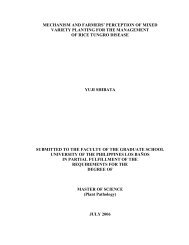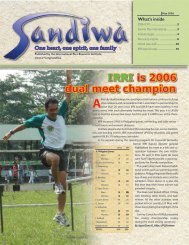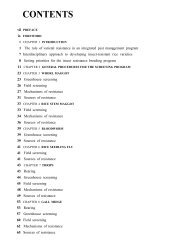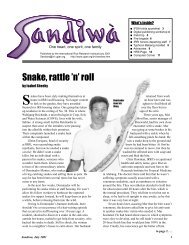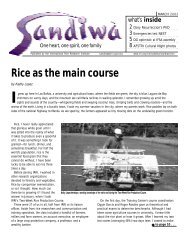Untitled - International Rice Research Institute
Untitled - International Rice Research Institute
Untitled - International Rice Research Institute
Create successful ePaper yourself
Turn your PDF publications into a flip-book with our unique Google optimized e-Paper software.
Table 4. Germination (%) of untreated and treated seeds using paper towel and in-soil germination methods (400<br />
seeds each; randomized complete block design).<br />
Normal a Abnormal Dead seeds<br />
Varieties Paper In-soil Paper In-soil Paper In-soil<br />
towel test towel test towel test<br />
Untreated<br />
IR62 79.7 ab 91.7 a 16.0 a 5.3 a 4.3 a 3.0 b<br />
SARBON 65.3 b 75.7 ab 20.3 a 12.0 a 14.3 a 12.3 ab<br />
C22 94.0 a 84.0 ab 4.3 b 10.3 a 1.7 a 5.7 ab<br />
BS1-10 68.0 b 72.7 b 18.3 a 11.0 a 13.7 a 16.3 a<br />
Hot-water treatment<br />
IR62 86.7 a 85.3 a 5.0 b 7.7 b 8.3 b 7.0 b<br />
SARBON 46.3 b 50.3 c 19.7 a 10.3 b 34.0 a 39.3 a<br />
C22 92.3 a 94.3 a 5.0 b 4.0 b 2.7 b 1.7 b<br />
BS1-10 76.3 a 67.7 b 13.7 ab 25.0 a 10.0 a 7.3 b<br />
a<br />
In a column under each treatment, means followed by a common letter are not significantly different at the 5% level by Duncan’s multiple range<br />
test.<br />
Relationship between seedborne inoculum<br />
and disease development in the field<br />
In determining the importance of a seedborne pathogen,<br />
it is essential to relate inoculum production and<br />
the efficiency of the secondary spread to the inoculum<br />
threshold and disease severity after establishment.<br />
For a monocyclic disease, initial infection<br />
should be closely related to the initial inoculum provided<br />
by the seed. For a polycyclic disease, a low<br />
level of seedborne inoculum is adequate to begin<br />
infection from the seedbed to the main field, and increase<br />
disease intensity if climatic or crop-growing<br />
conditions are favorable. For instance, in rice blast<br />
caused by P. oryzae with low detection and infection<br />
frequencies, seed-carried inoculum is more important<br />
in temperate or subtropical environments than in<br />
a tropical lowland environment. In the former environments,<br />
the likelihood of seed-carried inoculum<br />
beginning an infection and producing a sufficient<br />
amount of inoculum for secondary infection is higher<br />
(Ou 1985).<br />
Inoculum level and inoculum thresholds<br />
In seed health testing for certification, the inoculum<br />
threshold of seedborne pathogens is defined as the<br />
amount of seed infection or infestation that can cause<br />
a disease in the field under conducive conditions and<br />
lead to economic losses (Kuan 1988). We believe<br />
that this should mean a minimal amount of seed infection<br />
or infestation. In principle and as Gabrielson<br />
(1988) indicated, one infected seed may give rise to<br />
one infected plant, but, under field conditions, this is<br />
hardly the case. The values of the inoculum threshold<br />
for different crop-pathogen combinations in different<br />
countries vary widely (Gabrielson 1988).<br />
Our experience with rice has shown that the<br />
potential of a seedborne pathogen to cause a disease<br />
is determined by the type of pathogen in relation to<br />
the crop growth environment. Under conditions in a<br />
wet-bed nursery for rice seedlings, the likelihood of a<br />
fungal pathogen beginning an infection appears less<br />
than under tropical conditions. Perhaps this is because<br />
of the microbial competition or antagonism.<br />
On the other hand, if the level of seedborne inoculum<br />
is high (we have not had it quantified), then the probability<br />
of it causing infection is also high. As one infected<br />
seed begins one disease focus and this focal<br />
point expands, the probability of infection increases.<br />
In reality, disease establishment is affected by inoculum<br />
density and the crop cultivation environment.<br />
The more infected seeds there are (inoculum level),<br />
the higher the probability of having an infection.<br />
We have monitored detection levels of seedborne<br />
fungal pathogens from imported seed lots by<br />
planting them in the field after seed treatment for<br />
postentry plant quarantine observation. Diseases observed<br />
were not related to seedborne pathogens<br />
(Table 2). Pathogens from harvested seeds from<br />
these plants were detected, but we are not sure<br />
whether these fungal pathogen populations were the<br />
same as those carried by the original seed or if they<br />
came from other sources in the field.<br />
9



